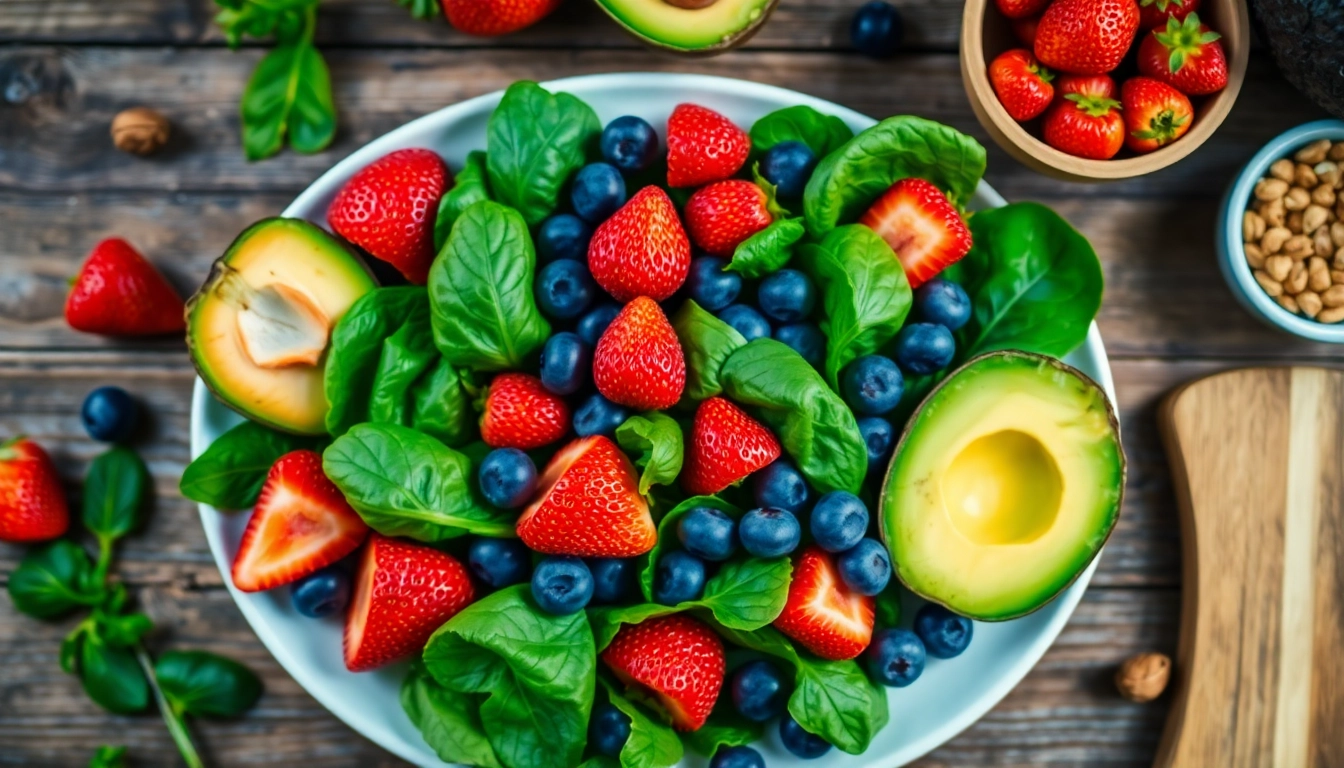Understanding the Basics of Healthy Food
In today’s world, where dietary choices are inundated with options ranging from highly processed snacks to organic produce, understanding healthy food has never been more crucial. At its core, healthy food encompasses a variety of nutrient-dense options that promote well-being and support bodily functions. For anyone looking to improve their diet, embracing healthy food choices is an essential step toward achieving a balanced and fulfilling lifestyle.
What Constitutes Healthy Food?
Healthy food is primarily defined by its nutritional value. A wide array of foods can be labeled as healthy, from whole foods such as fruits, vegetables, lean proteins, nuts, seeds, and whole grains to dairy products. The key is to focus on natural, unprocessed options that provide a balance of nutrients including:
- Vitamins and Minerals: Essential for various bodily functions, including immune support and bone health.
- Proteins: Crucial for muscle repair and growth; can be found in both plant and animal sources.
- Healthy Fats: Important for brain health and hormone production, found in avocados, olive oil, and fatty fish.
- Fiber: Aids in digestion and promotes satiety, found in fruits, vegetables, and whole grains.
In contrast, foods that are highly processed, contain excessive sugars, unhealthy fats, or artificial additives tend to exert negative effects on health.
Benefits of Incorporating Healthy Foods into Your Diet
The benefits of consuming healthy foods are numerous and far-reaching. Regularly including nutritious options in your meals can lead to:
- Weight Management: Nutrient-dense foods tend to be lower in calories and higher in fiber, which can help control hunger and reduce overall calorie intake.
- Chronic Disease Prevention: Diets rich in fruits, vegetables, and whole grains are associated with a lower risk of conditions such as heart disease, diabetes, and certain cancers.
- Improved Mental Health: There is growing evidence that a healthy diet can lead to better mood and cognitive function.
- Enhanced Energy Levels: Foods rich in nutrients can provide the sustained energy needed to power through daily activities.
Common Misconceptions About Healthy Food
Despite the growing awareness surrounding healthy eating, several misconceptions still proliferate. Some common myths include:
- All Fats Are Bad: While trans fats and excessive saturated fats can be harmful, healthy fats are crucial for the body’s functions.
- Carbohydrates Should Be Avoided: Whole grains and legumes are excellent sources of energy and vital nutrients and should be included in a balanced diet.
- Healthy Food Is Expensive: While organic products can be pricier, many affordable, nutritious options are readily available at grocery stores and markets.
Types of Healthy Foods You Should Include
Knowing what types of healthy foods to include in your daily diet is essential for maintaining a balanced nutrition profile. Here are some categories that should not be overlooked:
Fruits and Vegetables: Nature’s Superfoods
Fruits and vegetables are often regarded as the cornerstone of a healthy diet. Packed with vitamins, minerals, fiber, and antioxidants, they offer a multitude of health benefits. Aim to fill half your plate with these colorful foods during meals. Some examples include:
- Berries: Rich in antioxidants and vitamins, they support heart health and brain function.
- Leafy Greens: Staples like spinach and kale provide essential nutrients with low calories.
- Citrus Fruits: Oranges and lemons are excellent sources of vitamin C, vital for immune function.
Whole Grains and Their Importance
Whole grains such as brown rice, quinoa, and whole wheat products retain their bran and germ, making them richer in fiber and nutrients compared to refined grains. These foods are essential for:
- Digestive Health: The fiber content aids in regular bowel movements and prevents constipation.
- Heart Health: Consuming whole grains is linked to a reduced risk of heart disease.
- Weight Control: Whole grains slow down digestion, helping to manage hunger and cravings better than sugary snacks.
Proteins: Plant-Based vs. Animal Sources
Protein is vital for building and repairing tissues in the body. There are both plant-based and animal-based protein sources available:
- Animal Proteins: Lean meats, fish, eggs, and dairy provide complete proteins with all essential amino acids.
- Plant Proteins: Beans, lentils, tofu, and nuts can also offer adequate protein options and come with added health benefits from fiber and phytonutrients.
Including a variety of protein sources in your diet can enhance nutrient diversity, making it easier to meet daily protein needs.
How to Create a Balanced Meal with Healthy Foods
Creating balanced meals is key to maintaining a healthy diet. Understanding how to effectively integrate the various food groups can help ensure that you receive all the necessary nutrients.
Understanding Portion Sizes and Nutrient Balance
One of the main components of a balanced meal is understanding portion sizes. A useful method is the “plate method” where:
- Half your plate is filled with fruits and vegetables.
- One-quarter is dedicated to whole grains.
- The remaining quarter should feature a protein source.
This visual representation helps simplify meal planning and ensures a varied intake of essential nutrients.
Meal Prep Tips for Incorporating Healthy Foods
Meal prepping is an effective way to ensure you always have healthy food options on hand. Here are practical tips to get started:
- Plan Ahead: Dedicate time each week to create a meal plan, focusing on incorporating a variety of foods.
- Batch Cooking: Prepare large quantities of grains, proteins, and vegetables to portion out for the week.
- Use Storage Containers: Invest in good quality containers for easy storage and transport of your prepped meals.
Strategies for Eating Healthy on a Budget
Eating healthy doesn’t have to break the bank. Here are strategies to maintain a nutritious diet without overspending:
- Buy in Bulk: Purchase grains, beans, and nuts in bulk to reduce costs over time.
- Seasonal Produce: Choosing fruits and vegetables that are in season can lower prices and ensure freshness.
- Plan Your Meals: Creating a shopping list based on your meal plan can minimize impulse buys.
Healthy Food Recipes to Try at Home
Cooking healthy meals at home can be rewarding and enjoyable. Here are some simple yet nutritious recipes to inspire your journey:
Quick Breakfast Ideas Featuring Healthy Foods
Breakfast is a critical meal providing essential nutrients to kickstart your day. Here are quick and healthy options:
- Overnight Oats: Combine rolled oats, almond milk, chia seeds, and your choice of fruits to prepare a nutritious breakfast that’s ready to eat in the morning.
- Smoothie Bowl: Blend spinach, bananas, and almond milk, then top with granola, seeds, and fresh fruit for a refreshing start.
- Veggie Omelet: Whip up an omelet with eggs, spinach, tomatoes, and peppers to enjoy a protein-rich breakfast.
Lunch and Dinner Recipes Packed With Nutrition
For lunch and dinner, try these wholesome recipes that are both filling and nutritious:
- Quinoa Salad: Mix cooked quinoa with black beans, avocado, diced peppers, and a lime vinaigrette for a satisfying meal.
- Grilled Chicken with Steamed Vegetables: Grilling chicken and pairing it with steamed broccoli and carrots makes for a healthy and straightforward dinner.
- Vegetable Stir-Fry: Toss your favorite vegetables with tofu or chicken in a wok, seasoned with soy sauce, for a quick meal.
Snacks That Make Healthy Eating Easy
Healthy snacking can keep energy levels up throughout the day. Consider these nutritious options:
- Nuts and Seeds: A handful of almonds, walnuts, or sunflower seeds can provide a quick energy boost.
- Vegetable Sticks with Hummus: Crisp veggies like carrots and cucumbers paired with hummus make for a crunchy, satisfying snack.
- Greek Yogurt with Berries: Packed with protein and antioxidants, this sweet option is both delicious and healthy.
Maintaining a Healthy Food Lifestyle
Transitioning to a healthier diet is a journey filled with improvements and challenges. Here are ways to maintain your healthy food lifestyle for the long term:
Tracking Your Progress and Staying Motivated
Tracking progress not only helps in recognizing achievements but also maintains motivation. Consider these tracking methods:
- Food Journals: Maintaining a journal to log meals can increase awareness of eating habits.
- Apps: Numerous mobile apps are available to track food intake, exercise, and other wellness goals.
- Setting Goals: Establish short-term and long-term goals for your nutrition to keep your focus sharp.
Overcoming Challenges in Healthy Eating
Challenges in transitioning to a healthier lifestyle are inevitable. Here are some common hurdles and solutions:
- Time Constraints: Meal prepping can help alleviate the rushing around during the week.
- Cravings: Find healthy substitutes for your cravings, such as reaching for fruit when you’re craving sweets.
- Social Situations: Don’t hesitate to speak up about your dietary choices when dining out with friends or family.
Involving Family and Friends in Your Healthy Journey
Creating a supportive environment increases the chances of successful dietary changes. Here’s how to include those around you:
- Cooking Together: Organize healthy cooking nights where everyone contributes a dish.
- Shared Goals: Consider setting shared health goals with friends or family members to keep each other accountable.
- Educate Together: Sharing articles, resources, and experiences can turn healthy eating into a communal effort.



